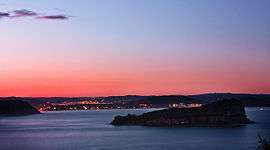Broken Bay
| Broken Bay | |
| Semi-mature tide-dominated, drowned valley estuary[1] | |
 Aerial photograph showing the mouth of Broken Bay as it flows into the Tasman Sea, as seen looking across Sydney's North Shore and Northern Beaches | |
| Country | Australia |
|---|---|
| State | New South Wales |
| Regions | Greater Metropolitan Sydney, Central Coast |
| Primary source | Hawkesbury River |
| Secondary source | Brisbane Water |
| Additional source | Pittwater |
| Mouth | Tasman Sea |
| - location | Box Head, Barrenjoey Head |
| - coordinates | 33°34′07″S 151°19′00″E / 33.56861°S 151.31667°ECoordinates: 33°34′07″S 151°19′00″E / 33.56861°S 151.31667°E |
| Depth | 9.8 m (32 ft) |
| Volume | 167,615 m3 (5,919,268 cu ft) |
| Basin | 12.9 km2 (5 sq mi) |
| Area | 17.1 km2 (7 sq mi) |
| Website: NSW Environment and Heritage webpage | |
Broken Bay, a semi–mature tide-dominated drowned valley estuary,[1] is a large inlet of the Tasman Sea located about 50 kilometres (31 mi) north of Sydney central business district on the coast of New South Wales, Australia; being one of the bodies of water that separate greater Metropolitan Sydney from the Central Coast. Broken Bay is the first major bay north of Sydney Harbour.
Broken Bay has its origin at the confluence of the Hawkesbury River, Pittwater, and Brisbane Water and flows openly into the Tasman Sea.
The total catchment area of the bay is approximately 17.1 square kilometres (6.6 sq mi).
Geography
The entrance to Broken Bay lies between the northern Box Head and Barrenjoey Head to the south. Barrenjoey Lighthouse was constructed in 1881 to guide ships away from the prominent headland. The bay comprises three arms, being the prominent estuary of the Hawkesbury River in the west, Pittwater to the south, and Brisbane Water to the north. These three arms are flooded rivers (rias) formed at a time when the sea level was much lower than it is at the present day.
The Hawkesbury River flows from the confluence of the Grose and Nepean Rivers at the base of the Blue Mountains.
Pittwater extends south from Broken Bay and is the northernmost extent of the greater Sydney area. Pittwater's calm waters make it a popular sailing area. West Head, west of Barrenjoey Head, marks the divide between Pittwater and the Hawkesbury.
Brisbane Water is the northern arm of Broken Bay and has the towns of Gosford and Woy Woy on its shores.
Lion Island, named for its profile's resemblance to a Sphinx from some viewpoints, is located at the entrance of Broken Bay. Lion Island Nature Reserve covers the entire island, and is home to a colony of fairy penguins.


European discovery
James Cook recorded "broken land" seen north of Port Jackson just before sunset on 7 May 1770, and named it Broken Bay. However, there has been some controversy over whether what is now known as 'Broken Bay' was what was sighted by Cook.
- Matthew Flinders, The colonists have called this place Broken Bay, but it is not what was so named by Captain Cook.[2]
Ray Parkin in his book H. M. Bark Endeavour claims that the modern 'Broken Bay' was passed unremarked at night, and that Cook was in fact referring to the area around Narrabeen Lagoon.[3] Matthew Flinders placed Cook's 'Broken Bay' at 33° 42' South, near to the mouth of Narrabeen Lagoon.[2]
Whatever the case, Governor Phillip was the first to examine the present day Broken Bay in a longboat from the Sirius on 2 March 1788.[4]
Role in attack on Sydney Harbour
On 28 November 2005, documentary film-maker Damien Lay claimed that the wreckage of M-24, a Japanese midget submarine involved in the attack on Sydney Harbour in 1942 and disappeared soon afterward, was buried under sand on the seabed, just east of Lion Island. Lay claimed to have confirmed that copper wiring found at the site was consistent with that used in similar Japanese vessels.[5] A few weeks later, New South Wales Planning Minister Frank Sartor announced that sonar scans conducted by the New South Wales Heritage Office at the location specified had found no trace of the lost submarine.[6]
M-24 was eventually found approximate 13 kilometres south of Broken Bay, 5 kilometres off Bungan Head, proving the hypothesis that M-24 chose to not draw attention to its mother submarines to the south of Sydney Harbour and instead moved north towards Broken Bay.[7]
Gallery
 Broken Bay from Flint and Steel Beach
Broken Bay from Flint and Steel Beach Lion Island with the Central Coast in the background
Lion Island with the Central Coast in the background
- Pearl Beach with Lion Island in the middleground and Pittwater in the background
 Umina Beach on the northern side of Broken Bay
Umina Beach on the northern side of Broken Bay
See also
References
- 1 2 Roy, P. S; Williams, R. J; Jones, A. R; Yassini, I; et al. (2001). "Structure and Function of South-east Australian Estuaries". Estuarine, Coastal and Shelf Science. 53 (3): 351–384. Bibcode:2001ECSS...53..351R. doi:10.1006/ecss.2001.0796.
- 1 2 A Voyage to Terra Australia, Vol Two page 2 (22 July 1802)
- ↑ Parkin, Ray (2003) [1997]. H. M. Endeavour (2nd ed.). Carlton, Victoria: The Miegunyah Press. p. 205. ISBN 0-522-85093-6.
- ↑ The Voyage of Governor Phillip to Botany Bay with an account of the Establishment of the Colonies of Port Jackson etc etc London 1789 page 9--~~~~
- ↑ Meacham, Steve (2005-11-29). "Down to the wire... solving a 60-year mystery". The Sydney Morning Herald: smh.com.au. Fairfax Digital. Retrieved 2008-10-23.
- ↑ "Investigation fails to find midget sub". ABC News Online. Australian Broadcasting Corporation. 2007-12-19. Retrieved 2008-10-23.
- ↑ Liam Bartlett (reporter), Stephen Taylor & Julia Timms (producers) (2006-11-26). "Found it!". 60 Minutes. Nine Network.
